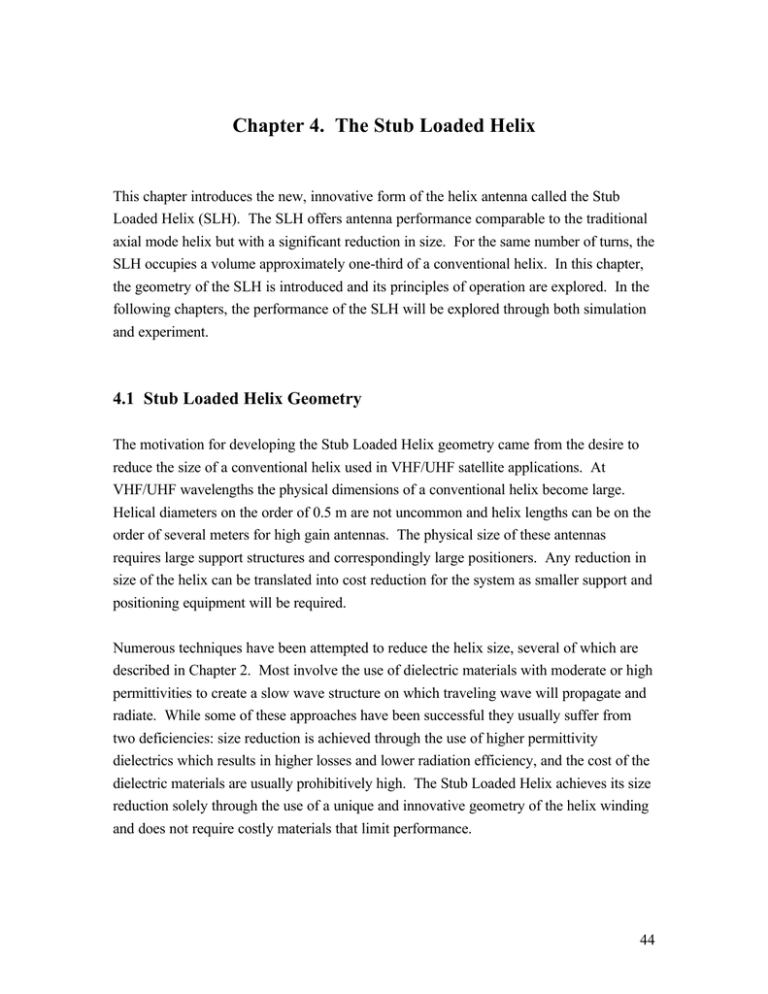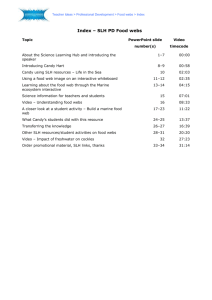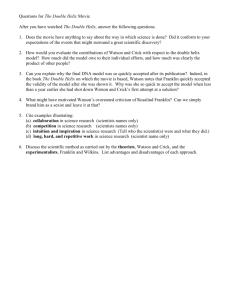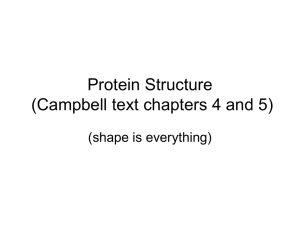Chapter 4. The Stub Loaded Helix
advertisement

Chapter 4. The Stub Loaded Helix This chapter introduces the new, innovative form of the helix antenna called the Stub Loaded Helix (SLH). The SLH offers antenna performance comparable to the traditional axial mode helix but with a significant reduction in size. For the same number of turns, the SLH occupies a volume approximately one-third of a conventional helix. In this chapter, the geometry of the SLH is introduced and its principles of operation are explored. In the following chapters, the performance of the SLH will be explored through both simulation and experiment. 4.1 Stub Loaded Helix Geometry The motivation for developing the Stub Loaded Helix geometry came from the desire to reduce the size of a conventional helix used in VHF/UHF satellite applications. At VHF/UHF wavelengths the physical dimensions of a conventional helix become large. Helical diameters on the order of 0.5 m are not uncommon and helix lengths can be on the order of several meters for high gain antennas. The physical size of these antennas requires large support structures and correspondingly large positioners. Any reduction in size of the helix can be translated into cost reduction for the system as smaller support and positioning equipment will be required. Numerous techniques have been attempted to reduce the helix size, several of which are described in Chapter 2. Most involve the use of dielectric materials with moderate or high permittivities to create a slow wave structure on which traveling wave will propagate and radiate. While some of these approaches have been successful they usually suffer from two deficiencies: size reduction is achieved through the use of higher permittivity dielectrics which results in higher losses and lower radiation efficiency, and the cost of the dielectric materials are usually prohibitively high. The Stub Loaded Helix achieves its size reduction solely through the use of a unique and innovative geometry of the helix winding and does not require costly materials that limit performance. 44 A schematic diagram of the Stub Loaded Helix is shown in Figure 4.1. The SLH consists of a helical winding around a central axis that is broken periodically by radially inward directed loading stubs. In Figure 4.1, four stubs per turn are shown, each stub positioned 90° with respect to the adjacent stubs. Because of the pitch angle of the helical winding, the stubs of a single turn do not lie in a common plane. The stubs are contiguous with the helix winding. The important geometric parameters for the Stub Loaded Helix are the diameter, D, the pitch angle, ! (related to the turn-to-turn spacing, S), the number of stubs per turn, Ns , the stub depth, 6= , and the number of turns, N. Typical values for these parameters are given in Table 4.1. Figure 4.1 Geometry of the Stub Loaded Helix antenna with important parameters. R radius of helix; ! - pitch angle, S - turn-to-turn spacing, and 6= - stub depth. 45 Table 4.1 Typical values of Stub Loaded Helix geometry Parmeter Value C - circumference 0.66 R - radius 0.106 D - diameter 0.212 ! - pitch angle 8° S - turn-to-turn spacing 0.093 N - number of turns variable Ns - number of stubs/turn 4 6= - stub depth 0.75*R (0.0795 -) L - axial length N*S Simulated and measured results indicate that the maximum reduction in helix diameter is approximately one-third. This corresponds to a helix circumference of approximately 0.66-c , where -c is the wavelength at the center frequency of operation. At a circumference much less than 0.66-c the radiation efficiency and axial ratio of the SLH begin to degrade significantly. Circumferences larger than 0.66-c may be used, but doing so would sacrifice some of the size reduction advantage of the SLH. When compared to the typical 1-c circumference of the traditional axial mode helix, the circumference of the SLH is significantly smaller. Figure 4.1 shows an SLH with four stubs per turn. In theory, an arbitrary number of stubs per turn can be used, but the length of the stubs should be adjusted so that the total length of each turn, including stubs, remains constant. The total path length around each turn, including stubs, is approximately 1.3-c at the center frequency of operation. Simulation studies were performed that indicate very little difference in antenna performance for four to ten stubs per turn. It was found that as long as the total length of a turn, including stubs, was kept constant the gain and size reduction performance of the SLH varied little. There was a slight variation of bandwidth with the number of stub per turn, not enough to make the choice of number of stubs a significant design factor. The larger the number of stubs per turn used, the more mechanically complex the antenna becomes. Thus, the majority of our experimental work has been with four stubs per turn SLH antennas. For a four stub per turn SLH, the typical stub length, 6= , is equal to threequarters the helix radius, or approximately 0.0795-c . 46 In Figure 4.1, the stub structure is shown as U shaped. In modeling the SLH, a squared off vee shape is used, as will be discussed in Chapter 5. In practice, the details of the stub construction are not critical. The gap created by the stub should be minimized as much as possible. If the stub gap is too large, there is a danger that the stub will begin to radiate and degrade the performance of the antenna. As long as the two sides of the stubs do not short together, almost any construction technique is viable. Our experimental models typically use enameled wire folded into a U-shape with the wire often touching. This has no effect on performance. Due to the smaller circumference of the SLH, the pitch angle, !, of the helix winding must be reduced from that of the conventional helix in order for the currents on successive turns to have the proper phase relationship to support endfire radiation. Conventional helices have pitch angles from 11° to 16° with a pitch angle of approximately 13° leading to maximum gain. In contrast, the Stub Loaded Helix optimum pitch angle is 8° with a typical range of 7°-9° providing acceptable results. The range of usable pitch angles is narrower for the SLH because of its smaller helix diameter. The smaller pitch angle results in a turn-to-turn spacing equal to approximately one-half that of conventional axial mode helices. The spatial phasing due to the geometry is more critical than that of a full size helix. While the numerical results indicate that the pitch angle may be sensitive, experimental results indicate that the SLH is quite forgiving of construction variations, almost as much so as a conventional full size helix. In summary, the Stub Loaded Helix geometry consists of a helical winding with periodic loading stubs around each turn. The circumference of the SLH is approximately 0.66-c and the depth of the loading stubs is approximately three-quarters of the helix radius, or 0.0795-c . The optimum pitch angle for the SLH is 8°. The one-third reduction in helix diameter and one-half reduction in turn-to-turn spacing characteristic of the SLH means that for the same number of turns, the SLH occupies a volume one-third that of a conventional axial mode helix. This 3:1 reduction in size is a significant improvement. As will be demonstrated in following chapters, this size reduction does have a performance penalty, but the penalty is small compared to the improvement in size and may be of no consequence in the applications of interest. 47 4.2 Principles of Operation for the Stub Loaded Helix The Stub Loaded Helix (SLH) should operate in a similar manner to the conventional axial mode helix. In order to understand the effect of the stubs on its operation and its size reduction compared to a conventional helix, we will examine the current along the winding on the helix in a manner similar to that for the conventional helix in the previous chapter. A NEC model of a Stub Load Helix with the design parameters in Table 4.2 was created and simulated within and below its operating bandwidth. The results are discussed below. In the results shown, all currents and phases are plotted as a function of axial length, as was done in Chapter 3 with the simulation results for the full size conventional helix. The currents and phases of the stubs have been removed from the results because the stubs effectively constitute zero length along the axis. This was also done in order to simplify the data presentation, because only the current on the helix proper contribute to radiation. Table 4.2 Design parameters of NEC simulated Stub Loaded Helix C, circumference 1m R, radius 0.5m fc , center frequency 210 MHz !, pitch angle 8° Ns , stubs/turn 4 ls , stub depth 0.75R N, number of turns 10 L, axial length 1.405 m Figure 4.2 shows the NEC current results for the SLH operated at 0.85 fc , which is below the nominal low frequency operating point of the SLH. The current exhibits a familiar standing wave pattern similar to that of the conventional axial mode helix as shown in Figure 3.9. The current magnitude does not look like a squared sinusoid as in Figure 3.9 because of discontinuities due to the stubs. Across the stubs there are small discontinuities in current magnitude, and phase, but these are not large, and as the figure illustrates, the current along the helix perimeter is approximately the same as on the conventional helix. This standing wave pattern indicates that both forward and reverse traveling waves of comparable magnitude are being supported on the SLH structure. Likewise in Figure 4.2(b), the phase along the helix is quite nonlinear. In part this is due to the phase step changes that occur across a stub, but even accounting for these steps, the current phase is 48 quite nonlinear. Again, it is similar to that observed in Figure 3.9 for the conventional helix operated below its operating frequency range. Figure 4.3 shows the NEC results for the SLH antenna being operated at its center frequency, fc . The helix current in Figure 4.3(a) shows a familiar shape. There is an almost linear decay of current magnitude along the axis from the feedpoint to turn 4. From turn 5 to the end of the helix, we see a familiar standing wave pattern, although it is somewhat distorted by the absence of the stub currents. However, the trend and similarity to the results for the conventional helix are obvious when compared to the simulation results in Figure 3.10(a). The phase results in Figure 4.3(b) is also similar to those for the conventional helix shown in Figure 3.10(b). An examination of the phase plot shows that there are step changes in the phase of the helix current. These step changes in phase correspond to the location of the stubs along the helix. This illustrates the primary function of the stubs, they provide a phase shift in the helix current in addition to that natural phase progression along the helix. The Hansen-Woodyard condition is also plotted on Figure 4.3(b) with the calculated current phase. The natural slope of the phase progression is less than the HansenWoodyard condition would indicate to support endfire operation. However, the step changes in phase, due to the stubs, increase the overall phase slope, resulting in a good stepwise approximation to the Hansen-Woodyard condition. As can be seen in Figure 4.3(b), the current phase along the helix perimeter is a reasonably good approximation to the Hansen-Woodyard condition over most of the helix length. 49 Turn 1 3 2 5 4 6 7 8 9 10 5 Current (mA) 4 3 2 1 0 0 10 f = 0.85 fc 20 30 40 50 60 70 80 90 100 110 120 130 140 150 Axial Length (cm) (a) Turn 1 2 3 4 5 6 7 8 9 10 150 100 Phase (deg) 50 0 -50 -100 -150 0 f = 0.85 fc 10 20 30 40 50 60 70 80 90 100 110 120 130 140 150 Axial Length (cm) (b) Figure 4.2 NEC simulated current (a) magnitude and (b) phase along the helix perimeter of a Stub Loaded Helix at f = 0.85 fc . Dashed vertical lines indicate boundaries between turns. Stub current and phase have been removed. 50 Figure 4.4 shows the NEC predicted pattern and axial ratio performance for this SLH antenna at 0.85fc and fc . The patterns are essentially similar, but the axial ratio performance is significantly different. At fc , the axial ratio on boresight is approximately 1.087 (0.8 dB). For f = 0.85 fc , the boresight axial ratio is approximately 3.33 (10 dB). It is typical for the SLH bandwidth to be most restricted by the axial ratio performance of the antenna. As shown in Figure 4.4, the pattern and gain behavior can still be quite good even where the axial ratio performance of the antenna has degraded significantly. In conclusion, the results of the simulations seem to imply two characteristics of the current on a helical structure that indicate axial mode radiation with circular polarization. They are a decaying current magnitude from the feedpoint along the helix and an approximately linear phase progression of the current phase along the helix axis that approximates the Hansen-Woodyard condition. These behaviors were observed in simulations of the conventional helix as well as those of the SLH. In the SLH, the natural phase progression along the helix structure is less than the requirements of the Hansen-Woodyard condition, but the step changes in phase increase the average phase slope so that it approximates the Hansen-Woodyard condition. These 'corrections' to the phase are the primary function of the stubs. 51 Turn 1 2 3 4 5 6 7 8 9 10 130 140 6 Current magnitude (ma) 5 4 3 2 1 0 0 10 f = fc 20 30 40 50 60 70 80 90 100 110 120 150 Axial length (cm) (a) Turn 1 2 3 4 5 6 7 8 9 10 180 160 140 120 100 Current phase (deg) 80 60 40 20 0 -20 -40 -60 -80 -100 -120 -140 -160 -180 0 10 20 30 40 NEC Hansen-Woodyard condition 50 60 70 80 90 Axial Length (cm) 100 110 120 130 140 150 f = fc (b) Figure 4.3 NEC simulation of current (a) magnitude and (b) phase along a Stub Loaded Helix at f = fc (- = -c ). Vertical dashed lines indicate boundaries between turns. Stub current and phase have been removed. In (b) the Hansen-Woodyard phase condition is also indicated. 52 (a) (b) Figure 4.4 NEC predicitons for the SLH of Table 4.2 operated at frequencies of 0.85 fc and fc ; (a) patterns and (b) axial ratio. 53 4.3 Comparison of the SLH and Conventional Helix In the preceding sections, we introduced the geometry of the Stub Loaded Helix and explaned its principles of operation. In the following chapters, we examine the electrical performance characteristics of the SLH through both computer simulation and experimental measurements. Before exploring the electrical performance of the SLH we present a comparison of the relative size and geometry of the conventional axial mode helix and the SLH. This is summarized in Table 4.3. Table 4.3 Comparison of Conventional Helix and SLH Geometry Parameter Conventional Helix SLH Circumference (@ fc ) 1 0.66 Diameter (@ fc ) 0.318 0.210 Radius (@ fc ) 0.160 0.105 Pitch angle, ! 12° - 15° 8° turn-to-turn spacing 0.21 - 0.26 0.093 3 volume/turn 0.01689 - 0.0209 0.00322 -3 For operation at the same center frequency, the diameter of the SLH helix is approximately 33% smaller than that of the conventional helix. Likewise, the turn-to-turn spacing of the SLH is smaller than that of the conventional helix by 50% or more. This is due to both the smaller pitch angle of the SLH helix winding and the smaller diameter of the SLH helix. The net result is that for the same number of turns, the SLH will have less than half the axial length of a conventional axial mode helix and helix volume of less than one-quarter that of a conventional helix. For an equal number of turns, this represents a significant reduction in helix size for the SLH over the conventional helix. However, this size reduction is only realized if the performance of the two helices are equal or comparable. In the succeeding chapters we will show through simulation and measurements that the performance of the SLH is comparable to a full size conventional helix with the same number of turns. As with any size reduction technique, there are compromises in performance resulting from the SLH geometry. But in the results that follow, we will show that these compromises are minimal and do not significantly impact most applications. 54 4.4 History of the Development of the Stub Loaded Helix The Stub Loaded Helix did not spring forth as a fully developed antenna design. As with most inventions, its development has been a long, and at times, winding path. In this section we document the development of the SLH to establish a formal record and to acknowledge the individuals and companies that have assisted us along the way. The genesis of the SLH began circa 1994 when the Virginia Tech Antenna Group began working with Astron Corporation (now Astron Wireless, www.astronwireless.com) on an SBIR (Small Business Innovative Research) grant to develop a reduced size helical antenna for satellite communications. The primary application was for the UHF military satellite communications systems. An early part of this work examined the internally matched helix, discussed in Section 2.2.5, and led to the development of the Slow-Wave helix, discussed in Section 2.2.6. When it was realized that the Slow-Wave helix had very narrowband performance characteristics, we began investigating alternative configurations. In 1995, the author conceived of replacing the zig-zag winding of the Slow-Wave helix with periodic stubs. The concept of the stubs was derived from the linear loading sections that are sometimes used for size reduction in wire antennas [Straw, 1997]. Consisting of a shorted section of closely spaced, parallel wires, the linear loading section of a dipole does not radiate but provides inductive loading to electrically lengthen the dipole. The same concept was applied to the SLH. Although the effect is slightly different, the concept is similar. Initial results of SLH performance were based solely on the results of NEC modeling. While modeling results are useful for evaluating candidate designs and performing parametric studies of design parameters, measured results are the most convincing and useful. However, the construction of appropriate prototypes introduces its own set of challenges. The original intent in the development of a reduced size helix was for application at UHF frequencies. The antenna testing facilities available would not accommodate an antenna of such a low frequency or large size. Thus, we began to develop prototypes at microwave frequencies, which were much smaller in size and could be accommodated on our antenna ranges. 55 Due to the complex geometry, building a prototype of the SLH was an exercise in mechanical engineering. The first successful prototype was built using a section of 3/4" delrin pipe as the support. It operated at 3.5 GHz. The technique of using a cylindrical tube to define the helix diameter and support the stubs has proven to be quite successful for our prototyping at microwave frequencies and has been continued in the commercially manufactured version of the SLH. More details of this construction technique is available in Chapter 7. In 1999 TurboWave (www.turbowave.com) of Orem, UT, licensed the SLH antenna from VTIP (Virginia Tech Intellectual Properties) for wireless LAN applications. Over the next several years VTAG worked with TurboWave and several manufacturers to develop an easily manufactured version of the SLH for the 2.4GHz WLAN market. Two distinct versions of the SLH, from two different manufacturers, emerged from those efforts. The first was an almost free standing structure developed by 3Di (part of Molex, Inc.) in Chicago, IL. Their version of the SLH is presented in Section 7.4. The second version was developed by FRC in Mason City, IA and is essentially identical to the prototypes developed at Virginia Tech, as discussed in Chapter 7, except that the process of forming the helix and stubs was automated. During the process of developing the SLH with TurboWave, their engineers discovered that the use of circular polarization at 2.4 GHz provided better penetration of foliage and within buildings than they had observed with linearly polarized antennas. As part of their testing, TurboWave built a large scale 802.11 network that covered the entire Utah valley (Provo and Orem, UT) using SLH antennas for all of their access points and linking to their point-of-presence (POP) units. Several former employees of TurboWave, working with RoamAD (www.roamad.com) in New Zealand have developed a demonstration 802.11 network in downtown Auckland using SLH antennas. The use of SLH antennas for their access points has been critical to their ability to provide ubiquitous coverage with a minimum number of access points. Thus, although originally developed for satellite communications, the SLH is seeing commercial success in the WLAN market. Development of the SLH antenna for satellite communications is continuing at present and may eventually prove fruitful in that market as well. 56






